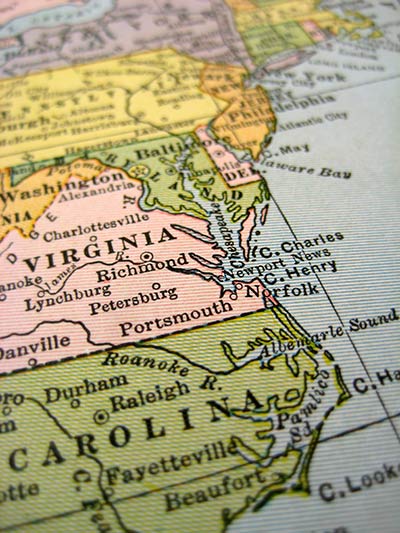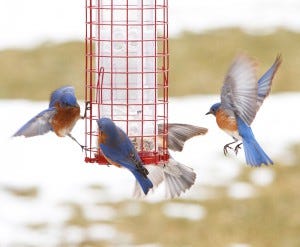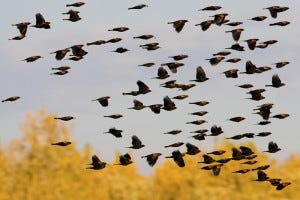Through the Fall and the Spring, many birds of North America set to wing in a twice a year ritual that sends them in search of food and breeding opportunities. In the Fall, they head South toward warmer climates with more food and less severe weather. In the Spring, it’s a northward journey to breeding grounds.
In the so-called Atlantic Flyway, a bird migration pattern that goes along the East Coast of North America, birds move through U.S. and often into Canada.
Some migrating birds, including the duck-like Eider and the Snowy Owl, can fly all the way to Greenland, the massive island nation East of Canada.
BIRD MIGRATION: ATLANTIC FLYWAY
 The states generally covered by the Atlantic flyway include Alabama, Connecticut, Delaware, Florida, Georgia, Kentucky, Louisiana, Maine, Maryland, Massachusetts, Michigan, Mississippi, New Hampshire, New Jersey, New York, North Carolina, Ohio, Pennsylvania, Rhode Island, South Carolina, Tennessee, Vermont, Virginia and West Virginia.
The states generally covered by the Atlantic flyway include Alabama, Connecticut, Delaware, Florida, Georgia, Kentucky, Louisiana, Maine, Maryland, Massachusetts, Michigan, Mississippi, New Hampshire, New Jersey, New York, North Carolina, Ohio, Pennsylvania, Rhode Island, South Carolina, Tennessee, Vermont, Virginia and West Virginia.
A significant section of Canada is also included in the flyway. The provinces and territories these birds head toward include Manitoba, Northwest Territories, Newfoundland and Labrador, New Brunswick, Nova Scotia, Nunavut, Ontario, Quebec, Saskatchewan and Yukon Territory.
The other flyways include the Central, the Pacific and the Mississippi. Other flyway maps can be slightly different than the one above — showing fewer states for each flyway. We opted to be more inclusive in which areas to include in the Atlantic Flyway.
LIST OF MIGRATORY BIRDS
The Audubon Society explains that about 500 bird species use the Atlantic Flyway, which actually covers a relatively small landmass. Instead, much of the flyway is over or very close to water, including the East Atlantic and the Gulf of Mexico.
Some species don’t travel through the entire flyway. Some merely migrate a few hundred miles or even over a mountain range that offers a more hospitable climate. Among those species using the Atlantic Flyaway, there are plenty of feeder birds, including:
- American Goldfinch
- American Tree Sparrow
- Baltimore Oriole
- Black-capped Chickadee
- Blue Grosbeak
- Blue Jay
- Brown Thrasher
- Chipping Sparrow
- Common Redpoll
- Dark-eyed Junco
-
 Eastern Bluebird
Eastern Bluebird - Eastern Meadowlark
- Eastern Towhee
- Evening Grosbeak
- Field Sparrow
- Hermit Thrush
- House Finch
- Northern Cardinal
- Northern Flicker
- Orchard Oriole
- Pine Grosbeak
- Pine Siskin
- Pine Warbler
- Purple Finch
- Red-breasted Nuthatch
- Red-winged Blackbird
- Ruby-crowned Kinglet
- Ruby-Throated Hummingbird
- Song Sparrow
- White-throated Sparrow
- Yellow-rumped Warbler
HOW YOU CAN HELP
 When you make a long trip, you’re tired — so expect birds to be just as exhausted as they complete each leg of their migration.
When you make a long trip, you’re tired — so expect birds to be just as exhausted as they complete each leg of their migration.
You can help migrating birds by providing them with a safe and welcoming place to rest, recover and refuel before they set out again. If you make things welcoming enough, they might even opt to stay for the season.
Some people believe that if you make things too nice, then you may alter a bird’s natural migration tendencies. That’s simply not true, every bird understands the risks of “staying put” and the possibility of getting “stranded” by the weather. If they’re staying in and around your yard, it’s because they want to, not because you’re tricking them to stay.
To make your yard more enticing to your feathered friends, a collection of feeders and waterers is important. Just as important is a place to roost and an opportunity for proper shelter.
For birds, shelter is a very relative concept. Certain birds have few requirements on what makes for proper overnight accommodations. Others have very specific needs for nesting.
- Look into the nest boxes that are appropriate for the birds that live in your area.
- Plant trees and bushes that create natural shelter.
- Move feeders to areas where predators can’t hunt.
- If you have a barn or shed, add some areas where birds can safely roost.
Likewise, consider helping with the science of birds, use the Perky-Pet® Hummingbird Migration Map, for example, to log your sightings of hummingbirds.
RECOMMENDED FEEDERS
The list of feeder birds above is huge and you’re sure to be able to help a lot of them with feeders from Perky-Pet®. A few ideas:
-
 Ruby-throated Hummingbirds: The primary hummingbird of the East Coast, Ruby-throats are beautiful and fun to watch. Keep your feeders bug free with this nectar feeder, which includes an ant moat and bee guards. Looking for something with a little more style, try this decorative glass bottle hummingbird feeder.
Ruby-throated Hummingbirds: The primary hummingbird of the East Coast, Ruby-throats are beautiful and fun to watch. Keep your feeders bug free with this nectar feeder, which includes an ant moat and bee guards. Looking for something with a little more style, try this decorative glass bottle hummingbird feeder. - Orioles: While the oriole population is slowly growing, these birds can be hard to attract to a feeder. Still they definitely know feeders that are built for them, including this beautiful nectar feeder. If you’re not sure there are orioles in your area, try an inexpensive oriole feeder first.
- Sparrows: Though not as flashy as some other birds, sparrows are certainly cute. They can refuel in your backyard too. Since sparrows are small birds, they appreciate the protection of caged feeders. Another option is a domed feeder that thwarts big birds like European Starlings.
- Song birds: Liven up your backyard by drawing in some songbirds. The Northern Cardinal loves sunflower seeds, and this wire-mesh feeder works perfectly. The chatty sounds of an American Goldfinch are always welcome, and you can draw them in by the dozens with a thistle feeder.








